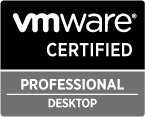For a list of all objectives see the VCP5 page.
Objective 5.1 – Create and Configure VMware Clusters
See also this similar post: Objective 5.1 – Create and Configure VMware Clusters and Objective 5.1 – Create and Configure VMware Clusters.
Describe DRS virtual machine entitlement (similar as vSphere 4.x)
The word entitlement is now usually referred to the vRAM entitlement, but in this context seems to be related on how work the DRS, for more info see the vSphere Resource Management Guide.
Create/Delete a DRS/HA Cluster (similar as vSphere 4.x)
See the vCenter Server and Host Management Guide (page 57), vSphere Resource Management Guide (page 51), vSphere Availability Guide (page 11).
Add/Remove ESXi Hosts from a DRS/HA Cluster (same as vSphere 4.x)
See the vCenter Server and Host Management Guide (page 56 and 113). Note that in order to add a host to an EVC cluster, you must put it in maintenance mode.
Add/Remove virtual machines from a DRS/HA Cluster (similar as vSphere 4.x)
Same of usual VM management. Just be sure that VMs are compliant with cluster requirements, like (for example) be on shared storage.
Configure Storage DRS (new in vSphere 5)
See the vSphere Resource Management Guide (page 77) and the VMware Storage DRS official page.
Configure Enhanced vMotion Compatibility (similar as vSphere 4.x)
See the vCenter Server and Host Management Guide (page 123) and VMware KB 1003212: Enhanced VMotion Compatibility (EVC) and VMware KB 1005764: EVC and CPU Compatibility FAQ.
Monitor a DRS/HA Cluster (similar as vSphere 4.x)
Understant the vSphere Client (and also the vSphere Web Client) interface.
Configure migration thresholds for DRS and virtual machines (similar as vSphere 4.x)
See the vSphere Resource Management Guide (page 54).
Configure automation levels for DRS and virtual machines (same as vSphere 4.x)
See the vSphere Resource Management Guide (page 57):
- Manual -> Initial placement: Recommended host(s) is displayed, Migration: Recommendation is displayed.
- Partially Automated n Initial placement: Automatic, Migration: Recommendation is displayed.
- Fully Automated n Initial placement: Automatic, Migration: Recommendation is executed automatically.
Create VM-Host and VM-VM affinity rules (similar as vSphere 4.1)
See the vSphere Resource Management Guide (page 71).
Enable/Disable Host Monitoring (similar as vSphere 4.x)
See the vSphere Availability Guide (page 24).
Enable/Configure/Disable virtual machine and application monitoring (similar as vSphere 4.1)
See the vSphere Availability Guide (page 26). Note that application monitoring need specific API used in the applications.
Configure admission control for HA and virtual machines (similar as vSphere 4.x)
See the vSphere Availability Guide (page 16) and vSphere 5.0 HA: Changes in admission control.
Determine appropriate failover methodology and required resources for an HA implementation (similar as vSphere 4.x)
See the vSphere Availability Guide (page 30).











